
Environmental Factor, January 2009, National Institute of Environmental Health Sciences
Global Health Meeting Highlights International Partnerships
By Eddy Ball
January 2009
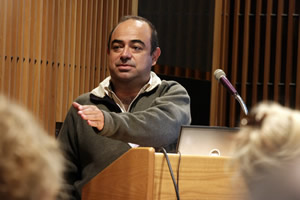
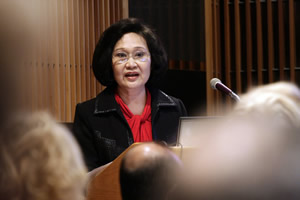
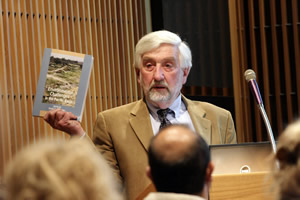
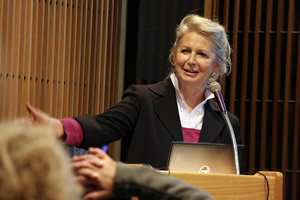
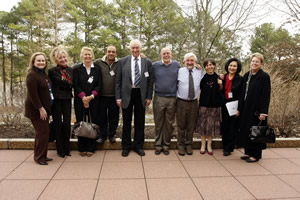
As part of the ongoing cooperative agreement between NIEHS and the World Health Organization (WHO), the NIEHS Division of Extramural Research and Training (DERT) hosted a mini-symposium on global environmental health December 4 in Rodbell Auditorium. The program, which featured talks by researchers in the Americas, Asia, Europe and Africa, was chaired by NIEHS Center for Risk and Integrated Sciences Acting Branch Chief Claudia Thompson, Ph.D., and organized with the help of a WHO employee in residence at NIEHS, Kathy Prout of the WHO Interregional Research Unit.
The talks presented research findings from around the world as one speaker after another addressed the importance of communications, training and multidisciplinary collaboration for impacting global health issues. Speakers offered specific examples of productive international collaborations and a bi-directional exchange of data and solutions.
The opening talk was presented by Fernando Díaz-Barriga, Ph.D., of Mexico’s Autonomous University of San Luis Potosí on the topic “Environmental Health Issues and Vulnerable Populations in Latin America: Do We Need a New Agenda?” Díaz-Barriga described his group’s work among the people in favelas, the poor areas adjacent to urban centers in South and Central America, and urged his audience to be receptive to findings of scientists in developing countries — to be prepared to “go south for solutions, not just for samples.”
The next talk, by Chulabhorn Research Institute Principal Investigator Mathuros Ruchirawat, Ph.D., emphasized the productive “Collaborative Initiatives on Arsenic and Health in Southeast Asia” with NIEHS grantees from Columbia University, the Massachusetts Institute of Technology (MIT) and the University of Arizona. Expanding her work beyond the borders of her native Thailand, Ruchirawat has established relationships with scientists and government officials in Vietnam and Korea.
Later in the program, University of Albany Director of the Institute for Health and the Environment David Carpenter, M.D., addressed the topic of “Fostering International Collaborative Research through Scientific Meetings.” He began by noting that although international scientific meetings and training may be easy targets for cutbacks in times of budgetary restraints, both are critical to establishing productive collaborations.
These activities are all about bringing parallel research interests and strangers together, Carpenter observed, noting his own record of more than 100 joint publications with researchers from nine other countries. Pointing to Ruchirawat’s training at MIT under NIEHS grantee Leona Samson, Ph.D., and Ruchirawat’s subsequent collaborations with Samson and NIEHS grantees Joe Graziano, Ph.D., of Columbia University and Vas Aposhian, Ph.D., of the University of Arizona, he argued that exchange programs and networking can establish valuable life-long research partnerships for the scientists who participate in them.
The meeting’s final speaker, WHO Department of Public Health and Environment Medical Officer Jenny Pronczuk, M.D., concluded her talk with a telling example of what international collaborations have accomplished in Africa. Faced with seemingly insurmountable threats to environmental health, including frequent “environmental health emergencies,” all 53 African nations in August signed the “Libreville Declaration on Health and Environment in Africa.”
In the declaration, the countries’ ministers reaffirmed their commitment to implement all conventions and declarations that bear on health and environment on their continent. The bulk of those conventions and declarations were established through international collaborative research and issued at scientific meetings of the kind fostered by WHO, NIEHS and other funding sources.
"2008 ONES Awardees Speak at NIEHS..." - previous story ![]()
![]() next story - "Study Examines Women’s Household Exposure Experiences..."
next story - "Study Examines Women’s Household Exposure Experiences..."
January 2009 Cover Page



